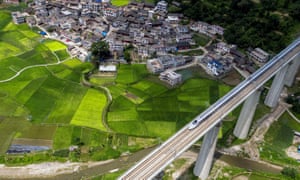Friday is Chinese new year and also the beginning of the spring festival, a national holiday in China (known as Chun Jie), which heralds what has been called the largest human migration in the world, with millions of people making journeys home for the holidays. China’s growing high-speed rail network – which is the longest in the world, too – carries a significant transport burden, with almost 60% of the population using it over a three-week-plus period.
It’s not just locals who can take advantage of the vastly improved journey times that the network offers: tourists too can use high-speed trains to visit more of China – and a whole lot faster. Many high-speed rail journeys are, ultimately, quicker than flying.

Tickets can be booked on Ctrip and delivered to a hotel. They can also be picked up from a station, though leave plenty of time for this, as queues can be long. Tickets can also be bought directly at stations or at offices dotted around cities. A passport is required to buy or pick up tickets, which are available 30 days in advance of travel. Trains get booked up quickly so it pays to be organised.
Daytime high-speed trains have first- and second-class seats; some have business class. Second-class seats are cheapest but still spacious and comfortable. Prices vary: one-way second-class from Shanghai to Beijing costs 553 RMB (£65) for the 819-mile journey, while the Beijing to Kunming service, currently the world’s longest high-speed rail route, costs around £130, second-class. China’s high-speed trains are generally divided into two types: G trains, which run at 186 mph (300km/h) and upwards, and D trains, which run at 155-186 mph (250-300km/h), track dependent.
Beijing to Kunming: train G403

This record-breaking service crosses 1,700 miles (more than 2,700km) from Beijing to Kunming, capital of Yunnan, the country’s most southwesterly province, in 10 hours and 43 minutes. It’s a long trip so you might wish to break up the journey at Wuhan, once one of China’s foreign concession ports. Changsha offers a day trip opportunity, with a visit to the hamlet of Shaoshan, birthplace of Mao Zedong. Further south, the city of Guiyang is a jump-off point for exploring Miao and Dong ethnic minority culture.
Lanzhou to Ürümqi: train D2701

This service, on China’s most westerly high-speed line, takes 11 hours and 31 minutes to connect Lanzhou, capital of Gansu province, with Ürümqi, capital of Xinjiang Uygur autonomous region. Essentially the Silk Road line, it travels between major points on the ancient trade route, including Zhangye, home of the Danxia mountains, and Jiayuguan, where the Great Wall ends. At points, the track reaches an altitude of 3,607 metres, making it the highest high-speed rail track in the world, while the train also stops at the oasis town of Turpan, geographically China’s lowest point at 154 metres below sea level.
Xi’an to Beijing: train G4020

After spending time in historic Xi’an, home of the terracotta warriors, as well as China’s most complete ancient city walls, this train arrives in Beijing in 6 hours and 35 minutes. It snakes its way along the Yellow river and en route stops at Luoyang Longmen, for an easy visit to the Longmen caves, a major Buddhist rock art gallery. From here it is also possible to visit the Shaolin Temple, where Chinese kung fu is said to have been developed.
Shanghai to Shenzhen: train D2287

Travelling along the coast from Shanghai to Shenzhen in 11 hours and 34 minutes, this train goes via picturesque Hangzhou, for a visit to its beautiful West Lake, passing through the semitropical provinces of Zhejiang and Fujian. It stops in the old port of Xiamen, once known as Amoy, where it’s possible to visit the colossal Hakka earthen roundhouses nestled in the countryside nearby. From technology capital Shenzhen, it’s an easy ride across to Hong Kong on the MTR (Mass Transit Railway).
Shanghai to Suzhou: train G7006

Not all high-speed rail journeys have to be long: the network is useful for making day trips from China’s major cities. This train whisks you from Shanghai’s skyscrapers to the canals and gardens of Suzhou in 25 minutes. The frequent return trains make this an easy day away from the world’s biggest city but given that Suzhou’s red lantern-lined streets are especially charming at night, you may decide to stay over instead of rushing back.
Shanghai to Beijing: train G14

It’s possible to travel the 819 miles between China’s two most prominent cities in just 4 hours and 28 minutes. To visit Shanghai and Beijing is to understand the distinct facets of modern China. Shanghai, with its skyscrapers and fast-talking residents, showcases the entrepreneurial energy that has seen China’s economy develop. Beijing, however, is all about history and politics, with Chairman Mao’s huge portrait still gazing out across Tiananmen Square from the gates of the Forbidden City, once home to China’s emperors.
This article contains affiliate links, which means we may earn a small commission if a reader clicks through and makes a purchase. All our journalism is independent and is in no way influenced by any advertiser or commercial initiative. By clicking on an affiliate link, you accept that third-party cookies will be set. More information.


View all comments >